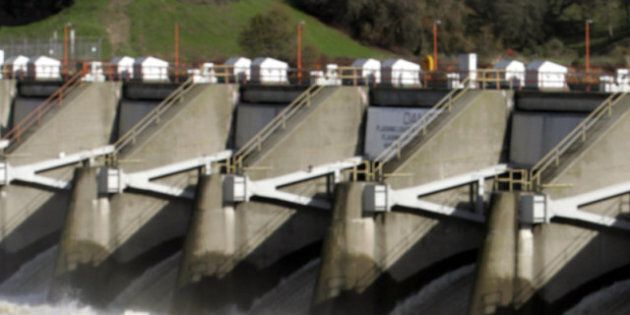
Commentators in the United States often lament the country's seeming loss of will to take on the kinds of big infrastructure projects that made the nation great in the first place; founding the Tennessee Valley Authority in the 1930s to provide electricity and economic development to Tennessee and six neighboring states; providing long distance road travel throughout the lower 48 states by constructing the Interstate Highway System beginning in 1950s; and, of course, landing men on the Moon in the Apollo program of the 1960s, which spurred scientific and technological innovations that continue to today, just to name a few.
China meanwhile seems to be getting on with the business of building a 21st century country. A new, $5 billion US, 2,525 kilometer (1,575 mile) railway between Beijing and Hong Kong was completed in 1997, and there are plans to spend $100 billion US to lay down tracks for a 12,000 kilometer (7,500 mile) high-speed railroad, running trains at speeds up to 300 kilometers (185 miles) per hour.
The Three Gorges Dam is the world's largest and costliest (estimated at $30 billion US or more) hydro power project ever undertaken, with a capacity to produce of 18,000 megawatts of electricity. The reality of a non-democratic country boldly building big things intended to service a large modern state challenges the paradigm taught for decades that only democracies can produce such successes.
It is with this background that news reached us on Canada Day (July 1) that the Innu Nation of Labrador ratified the New Dawn Agreement, marking another step toward the start of the Lower Churchill Project, a hydroelectric development that will transmit electrical power from Labrador, across the Strait of Belle Isle, down to the island of Newfoundland, and then across the Cabot Strait into Nova Scotia, with the possibility of exporting excess power to the rest of the Maritimes and New England.
It is an audacious plan undertaken by two Canadian provinces, Newfoundland and Labrador and Nova Scotia, with a combined population of only about 1.5 million people. It should remind us that the ability to tackle big infrastructure projects is still alive in North America, and inspire us to embrace similar projects elsewhere.
The project in Atlantic Canada is estimated to cost between $6-$9 billion CAD (the Canadian and US dollars are approximately at parity at present) for construction of a 824-megawatt generating facility at Muskrat Falls on the lower Churchill River in Labrador; a 1,100-kilometer (680 mile) transmission link to the island of Newfoundland, including 30 kilometers (19 miles) of submarine cable; a maritime link to Nova Scotia including 180 kilometers (112 miles) of submarine cable; and other transmission infrastructure.
The New Dawn Agreement includes provisions for native peoples in Labrador to receive a royalty of five per cent of net project revenue and payments of $2 million CAD per year until the project first begins generating commercial power, expected to be in 2017. Forty per cent of the electricity output will be sold to customers in Newfoundland, replacing the current oil-burning facility that generates electricity on the island; 20 per cent will provided to Nova Scotia customers, representing almost 10 per cent of the province's domestic needs; and the remaining 40 per cent will be available for sales to other parts of the Maritimes or in the United States. There is an option to expand the development significantly later, by building a 2,250-megawatt hydroelectric plant at Gull Island, further upstream on the lower Churchill River.
The project is not without its challenges or critics. Taxpayers in Newfoundland and Labrador will be burdened with the capital costs of the development and electricity prices for customers will inevitably increase. Even Nalcor Energy, the provincial crown corporation power utility responsible for the project in Newfoundland and Labrador estimates that customers in the province will pay about 15 cents per kilowatt hour for electricity in 2017 compared to about 10 per cent today.
Some have argued that the total project costs are likely to be closer to $15 billion CAD so the costs to taxpayers may be much more than those predicted now. The project is already behind schedule and it is unclear if power will really begin flowing by 2017. Some have doubted that markers for electricity generated by the project will exist in New England and other eastern U.S. states in the coming decades if local sources of energy continue to be available, particularly natural gas hosted by shale rocks, which seems much more abundant than was thought even just a few years ago.
While many of these concerns may be true, what many miss is that big infrastructure projects are, by their very nature, high risk, high reward enterprises. One does not go into them lightly but, at the same time, one should not let their uncertainties provide cover for a lack of courage to take them on.
Intangibles play a role in predicting the future. In this case, hydroelectric power generation has a small carbon footprint compared to many other energy sources, and it is very possible that in the years to come, this source of energy will become highly valued in a world struggling mightily to reduce greenhouse warming.
This is not to say that damming rivers and flooding lands does not have adverse environmental impacts and perhaps other technologies such as wind and solar power seen as even more "environmentally-friendly" will be more appropriate for some regions than hydroelectric plants. Which leads to the final point -- debating when and where to tackle big infrastructure projects, and which ones, is still an advantage held by democracies.